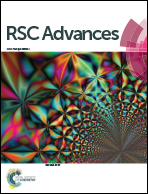Several ionic organic compounds as positive electrolyte additives for a vanadium redox flow battery
Abstract
Several ionic organic compounds have been employed as additives of the V(V) electrolyte for a vanadium redox flow battery (VRB) to improve its stability and electrochemical activity. Stability of the V(V) electrolyte with and without additives was investigated with an ex situ heating/cooling treatment over a wide temperature range of −5 °C to 60 °C. It was found that cationic organic compounds could significantly improve the stability of the V(V) electrolyte over a wide range of temperatures. Their electrochemical behavior in the V(V) electrolyte was further studied by cyclic voltammetry (CV) and steady state polarization. The results showed that the electrochemical activity, including the reversibility of the electrode reaction, the diffusivity of V(V) species, polarization resistance of V(V) species, and the flexibility of charge transfer for the V(V) electrolyte with these additives were all improved compared with the pristine solution. The VRB employing the positive electrolyte with cationic organic compounds as additive exhibited excellent charge–discharge behavior with an average energy efficiency of more than 80% at a current density of 20 mA cm−2. XPS spectra illustrated that the addition of CHPTAC introduced more oxygen-containing and nitrogen-containing functional groups, which improved the electrochemical performance and cycling stability of the VRB.


 Please wait while we load your content...
Please wait while we load your content...